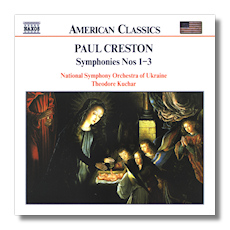
The Internet's Premier Classical Music Source
Related Links
- Latest Reviews
- More Reviews
-
By Composer
-
Collections
DVD & Blu-ray
Books
Concert Reviews
Articles/Interviews
Software
Audio
Search Amazon
Recommended Links
Site News
 CD Review
CD Review
Paul Creston

Symphonies #1-3
- Symphony #1, Op. 20 (1940)
- Symphony #2, Op. 35 (1943)
- Symphony #3 "Three Mysteries", Op. 48 (1950)
National Symphony Orchestra of Ukraine/Theodor Kuchar
Naxos "American Classics" 8.559034 DDD 72:39
This is an extremely valuable issue. To my knowledge the only currently competing issues of symphonies by Paul Creston (1906-85) are on Delos, with conductor Gerard Schwarz, whose two CDs feature the Third Symphony in the first volume and the Fifth in the second. Both have interesting orchestral fillers and are still worthwhile purchases. But this Naxos CD is more intelligently packaged, fitting three symphonies onto one disc, and offers a better deal with its budget price. The performances here are also quite excellent, this Ukrainian group continuing to distinguish itself in the American Classics series, along with its talented and incisive conductor, Theodor Kuchar. Actually, Kuchar's contract with the N.S.O.U. was scheduled to expire in 1999 but may have been renewed.
In any event, the works here are quite worthwhile, the energetic First Symphony (1940) being quite a pleasant surprise to me. While I find the Second and Third perhaps slightly deeper works, the First is skillfully written for an initial effort and doesn't contain a moment's note-spinning. Its four movements are subtitled thusly: With Majesty, With Humor, With Serenity and With Gaiety. Only the first movement's subtitle is slightly misleading as the music is full of energy and muscle. Yes, there's majesty, too, but I'm not sure that's the overall impression left by the music here. Anyway, the work is a strong one and well worth knowing.
The Second Symphony (1944) sounds a little more American, as if in the intervening four years the composer had come under the influence of Hanson and Harris. Yet, the voice of these composers is in no way a dominating element in the score – the music still sounds like Creston's. This twenty-two minute work, a tad shorter than its predecessor, is divided into two movements, the first mostly songful and lyrical, the second rhythmic and powerfully dramatic. In the end, it's probably a better work than the First, but only marginally so.
The Third Symphony (1950) is comprised of three movements, each carrying a subtitle: The Nativity, The Crucifixion and The Resurrection. The work's subtitle, Three Mysteries, refers to these events in the life of Christ, which are mysteries from the three-decade Roman Catholic rosary, comprised of the Joyful, Sorrowful and Glorious mysteries. Here the composer depicts the pivotal mystery from each decade. Creston obviously put much effort into this work, using Gregorian chant to form his melodic material and creating a musical landscape of considerable scope. He wanted to express his deepest religious convictions in this symphony, but I'm not sure he succeeded. While the work is melodically appealing, colorfully and effectively scored, and powerfully dramatic, its subject matter demands a vast emotional and intellectual range, and one is prompted to make comparison with so many similar works in the Classical repertory. The Resurrection here, for example, doesn't nearly have the memorable impact of that event in Mahler's Second. Still, this is a fine work, and from an American perspective its religious spirit has a poignancy and humanity, a modernity that seems to presage Vatican II.
As mentioned above, the performances are excellent. Naxos provides vivid sound and informative notes.
Copyright © 2000, Robert Cummings




















